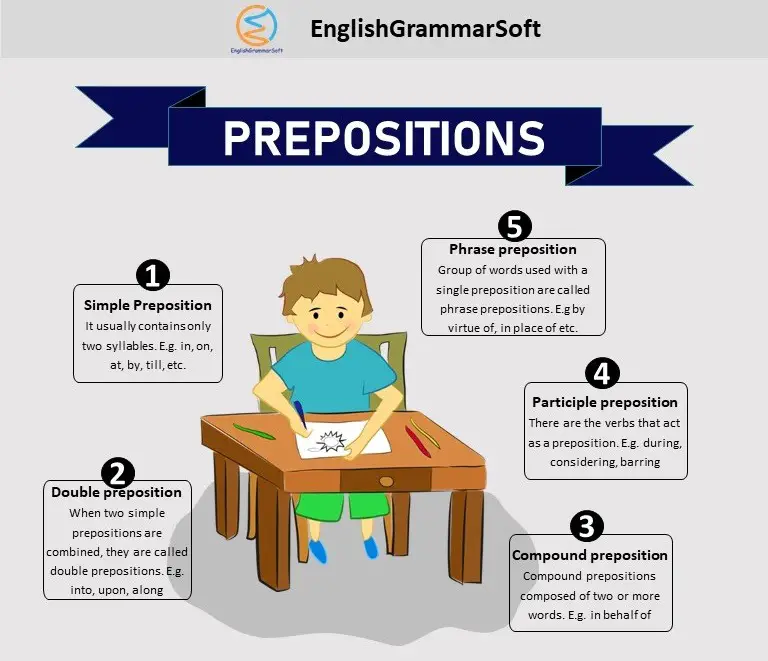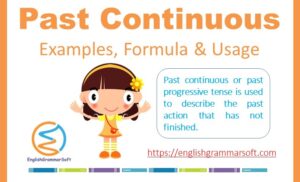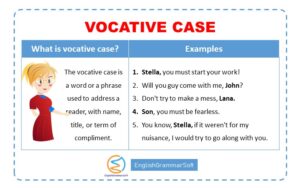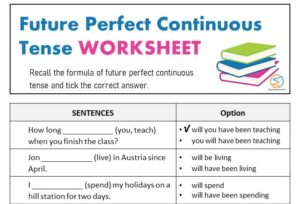What is a preposition? Types of Preposition According to Function
In this post, we are covering preposition, its types with examples and rules. Following points will be covered.
- What is a preposition?
- List of Prepositions
- Types of Preposition
- Types of Prepositions According to Function
- Rules of Preposition
1 – What is a Preposition?
A preposition is an important part of the English language and grammar. Prepositions are common but they seem complicated when we use them. These are the words used to link the noun and pronoun or other words.
Preposition is used to prove a correlation between nouns and pronouns in a sentence.
Examples
- She is going to school.
- He put the flowers by the door.
- The jug was placed on the table.
In above sentences the bold words are prepositions.
Preposition + Noun
I gave the jug to Alan.
Preposition + Pronoun
I gave the wallet to him.
Preposition + Gerund
I devoted my time to stitching.
2 – List of Prepositions
- Above
- About
- Absent
- Across
- After
- Along
- Among
- Around
- As
- Before
- Behind
- Below
- Beside
- Beneath
- Between
- Beyond
- By
- Considering
- Despite
- During
- Except
- For
- From
- Given
- In
- Inside
- Into
- Minus
- Of
- Off
- On
- Onto
- Opposite
- Outside
- Over
- Per
- Plus
- Round
- Since
- Than
- Through
- To
- Towards
- Under
- Until
- Up
- Upon
- Via
- Without
- Within
3 – Types of Preposition
There are different types of prepositions
- Simple preposition
- Double preposition
- Compound preposition
- Participle preposition
- Phrase preposition
3.1 – Simple Preposition
It usually contains only two syllables.
Simple prepositions are; by, at, in, of, off, out, till, up, to, with, on, etc.
Simple Preposition Examples
- Cat sat on the bed.
- There is some water in the jug.
- He is working hard to pass the exam.
- My baby is suffering from flu.
- I am from Islamabad.
- She is working at grocery store.
- This book belongs to Tom.
3.2 – Double preposition
When two simple prepositions are combined, they are called double prepositions. They habitually indicate directions.
Double prepositions are
- into
- upon
- along
- onto
- out of
- behind
- without
- within
- next to
Double preposition examples
- Once upon a time, there was a lion.
- The cat climbed onto the table.
- The dog is sitting behind the chair.
- Hira never goes out without her mobile.
- The ducks are eating along the river.
- The bank is next to the post office.
3.3 – Compound preposition
Compound prepositions composed of two or more words. They are easy to known because the last word of a compound preposition is always simple preposition.
Compound preposition = Prefix + Noun / adjective / adverb
Compound prepositions are
- In behalf of
- According to
- Beyond
- In front of
- Beneath
- Besides
- Between
- Without
- Around
Compound preposition examples
- The children ran around the table.
- His personality is beyond imagination.
- There is a station beneath this area.
- There is a show inside the box.
- The dog is jumping around the seat.
- The auto pulled along the drive way.
- She is picked in front of bank.
3.4 – Participle preposition
There are the verbs that act as a preposition. Frequently, such words end in –ing and –ed.
Participle prepositions are
- During
- Considering
- Barring
- Provided
- Laughing
- Concerning
- Frustrated
Participle prepositions examples
- The teacher, sometimes gets frustrated with her class.
- Everyone, please keep quiet during the class.
- The kept following her home.
- Considering his education, he did a great job.
- Sara is interested in anything concerning novels.
- All the brothers were there including the mother.
3.5 – Phrase preposition
Group of words used with a single preposition is called phrase preposition.
For example,
- On the behalf
- On time
- At home
- Before class
- By virtue of
- Inspite of
- In place of
- On the floor
Sometimes they are used as an adverb and sometimes as a preposition.
- A word is preposition when it adds noun or pronoun. For example, The knife lies in the basket.
- A word is an adverb when it adds verb. For example, Let’s move on.
Phrase preposition = Preposition + object + modifier
- Jon received the trophy on the behalf of his friend.
- The match got canceled because of heavy rain.
- I will get to the class on time.
- Teacher met to discuss lecture before class.
- In course of time, the wounds healed.
4 – Types of Prepositions According to Function
There are many types of prepositions according to function.
- Preposition of time
- Preposition of place
- Preposition of manner
- Preposition of cause and effect
- Preposition of instruments / devices
- Preposition of direction / movement
- Preposition of agent
4.1 – Preposition of time
These types of prepositions show time in a sentence. It discusses the specific time period like dates, days of the week etc.
Preposition of time
- At: Used for precise time.
- In: Used for months, years, centuries and long periods.
- On: Used for days and dates.
Table
| AT | IN | ON |
| At 9 o’clock | In June | On Monday |
| At night | In the spring | On 8 February |
| At breakfast | In 1991 | On Sunday |
| At dinner | In December | On a summer eve |
| At noon | In the age | On independence day |
| At school | In the past | On my birthday |
| At college | In the future | On new year’s eve |
| At university | In the summer | On the way |
| At home | In a row | On a ship |
| At sunrise | In the garden | On a radio |
| At the moment | In the sky | On 30th June 2010 |
| At the cinema | In winter | On the wall |
Uses of at
- We have a meeting at 9 a.m.
- I went home at lunch time.
- We have a party at midnight.
- The shop closes at 6 o’ clock
- The stars shine at night.
At is used to express
- Exact time at 5 o’ clock
- Meal time at lunch
- Festivals at New Year
- With age at the age of 20
- Time at this time
Uses of in
- I shall return in an hour.
- In this town, it often rain in July.
- Would you think we will go to Greece in the future?
- I shall be successful in the next year.
- We will go to hill station in the summer.
In is used to express
- Parts of the day in the morning
- Months in December
- Centuries in 20th Century
- Years in 2013
- Season in Autumn
- Time period in those days
Uses of on
- I work on Monday.
- His birthday on 1st April.
- Vacations end on Tuesday.
- We are going to Texas on 1st June.
- We will meet on Friend’s Day
On is used to express
- Festivals on independence day
- Dates on 1st May
- Days of the week on Monday
- Occasion on that day
- Anniversaries on wedding day
4.2 – Preposition of Place
These types of prepositions show a place in a sentence.
- At: It is used to discuss a certain point.
- In: It is used an enclosed space.
- On: It is used to discuss a surface.
Examples of Preposition of Place
Uses of In
- I live in Multan
- She is in the bus.
- He is the most famous artist in the world.
- She watches TV in the room.
- Google is the best search engine in the world.
Uses of At
- I met him at the bust stop.
- We are going to watch the movie and we met him at cinema.
- Sun rises at 05:30 a.m.
- There is a rod at the roof.
Uses of On
- Look at the lizard on the wall.
- There is a book on the table.
- There is a smile on her face.
- My room is on the first floor of the hotel.
- There is a beautiful picture of my father on the wall.
4.3 – Preposition of Manners
Preposition of manners are about the method something happens or how something is complete. Commonly used words are “by” and “with”. Some other words are also used (in, like, on).
Examples
- She will dies by the cancer.
- Teacher faces students with big courage.
- My baby sings like a cuckoo bird.
- We are going by taxi.
- The tourist arrived on the island on a bus.
4.4 – Prepositions of cause and effect
They are used to show the cause of something or a reason of something done.
Commonly used words are; due to, because of, from hence, on account, therefore through etc.
Examples
- He cannot run the bicycle because of his leg.
- He is sick from fever.
- Her sales increased repeatedly through good marketing.
- The quarrel was increased due to discourtesy of both sides.
- She does not eat meal regularly on account of her disease.
4.5 – Preposition of Devices / Instrument
This type of preposition is used to express different technologies, machines or devices. Some words are used for, by, with and on.
On, with = describe the use of machines and devices.
For examples,
- My aunt is back home by taxi.
- Bob opened the lock with an old key.
- May I do my work on your computer?
- We are going on a trip by ferry.
- My work is done with the use of your cell phone.
4.6 – Preposition of Direction / Movement
This type of preposition tell us a direction or location of something.
Some words used are
- Across
- Along
- Among
- At
- Behind
- Below
- Into
- Towards
- Onto etc.
Examples
- Supervisor walked towards the examination hall.
- Sana was sitting among her family.
- Meet me at the bus stop.
- The ducks are eating along the river.
- I have the poster below the mirror.
4.7 – Preposition of agent
These types of prepositions are used to show a causal connection between noun and usually a verb. Words used as preposition of agent are:
- By
- With
Examples
- A literature book was written by John Keats.
- This work was done by me.
- Some institutes were closed by government.
- Hira graduated with a public administration degree.
Some commonly used prepositions are:
In front of
It is used to show that someone is standing in front of other person. For example,
The teacher stands in front of the class.
Behind
It is used to show that at the back of something.
Example
There is a shoe behind the table.
Between
It is used to show that two things or boejcts
Example
There is a strong relationship between Tom and Alice.
Across from
It is used to show an opposite direction.
Example
She lives across from school.
Next to
It is used to show that a person that is at the side of another thing.
Example
A guard stands next to the entrance gate.
Under
It is used to show low level of something.
Example
There are boxes under the bed.
5 – Rules of prepositions
There are three rules
- Pair them accurately.
- Watch what follows them.
- Avoid using them at the end of sentences
5.1 – Pair them properly
Determining which preposition to exercise be a capable of tricky prepositions. It is notably difficult when dealing with idioms. Idiomatic expressions are expressions you just give birth to memorize, and at what time errors are made.
That’s why you need to write them accurately with their places and easy to understand.
5.2 – Watch what follows them
Prepositions are always be followed by a noun / pronouns. The noun is called the object of preposition. Note that a verb can’t be the object of a preposition.
Example
The bone was for the dog. (correct)
The bone was for walked. (incorrect)
5.3 – Avoid using them at the end of sentences
Because prepositions must be followed by a noun and have an object, they should rarely be sited at the end of sentences.
Example
The table is where I put my books on. (incorrect)
I put my books on the table. (correct)
Further Reading:







